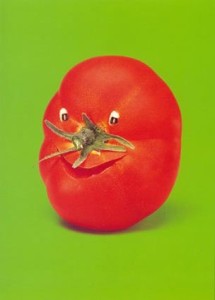I always liked it when Stephen Colbert’s alter ego referred to U.S. National Public Radio as state-sponsored jazz.
So 20 years after greenhouse tomatoes from Leamington, Ontario, Canada, became a big thing in the U.S., Dan Charles of NPR has driven to Leamington, to document the biggest concentration of greenhouses in North America.
I’d rather listen to the real French acoustic jazz playing outside my window in Montpellier (right, exactly as shown).
The NPR story is a puff-piece, soothing to the ears and palate (journalists have a more suitable description) that fails to mention the June 6, 2016 ruling in which Kingsville, Ontario-based Mucci Pac Ltd., Mucci International Marketing and two of its executives were ordered to pay $1.5 million in fines in a case filed by the Canadian Food Inspection Agency for mislabeling Mexican produce as Canadian-grown.
In addition to the fine, the companies will operate under a probation period for three years.
CFIA filed charges against the Mucci companies, general manager Danny Mucci and vice president of sales Joe Spano in 2014. The charges involved fraudulent misrepresentation of country of origin for imported peppers, tomatoes and cucumbers from November 2011 to January 2013.
When the charges were filed, CFIA named the public at large and three retailers — Costco Wholesale, Loblaw Cos. and Sobeys Inc. — as the victims of the misrepresentation.
Mucci International Marketing and Mucci Pac each pleaded guilty to three violations of Canada’s Food and Drugs Act and the Canada Agricultural Products Act, according to CFIA.
Mucci and Spano each pleaded guilty to a violation of the Canada Agricultural Products Act.
In a June 7 statement, the Mucci companies said CFIA investigators found “anomalies in our computer records.”
 “We take responsibility for those mistakes and have promised to make every reasonable effort to ensure that this does not occur in the future,” according to the statement.
“We take responsibility for those mistakes and have promised to make every reasonable effort to ensure that this does not occur in the future,” according to the statement.
The companies said that they were guilty of “regulatory offenses,” which is not the same as admitting they committed a crime.
In a statement, the Leamington-based Ontario Greenhouse Vegetable Growers said the mislabeling of produce is an issue “of great concern” to its grower members.
“We view the convictions as a serious matter, and we will be reviewing the evidence presented in this case and will take whatever actions that we deem appropriate to protect the sector, our producers and consumers.”
Uh huh.
Here’s a couple of more scientific things to consider.
Poop in the greenhouse: Survival of pathogens
U.S. Food and Drug Administration standards include 90- or 120-day intervals between application of manure and harvest of crop to minimize risks of pathogen contamination of fresh produce. Data on factors affecting survival of Escherichia coli in soils under greenhouse conditions are needed.
Three separate studies were conducted to evaluate survival of nonpathogenic E. coli (gEc) and attenuated E. coli O157:H7 (attO157) inoculated at either low (4 log CFU/ml) or high (6 log CFU/ml) populations over 56 days. Studies involved two pot sizes (small, 398 cm3; large, 89 liters), three soil types (sandy loam, SL; clay loam, CL; silt loam, SIL), and four amendments (poultry litter, PL; dairy manure liquids, DML; horse manure, HM; unamended). Amendments were applied to the surface of the soil in either small or large containers.
Study 1, conducted in regularly irrigated small containers, showed that populations of gEc and attO157 (2.84 to 2.88 log CFU/g) in PL-amended soils were significantly (P < 0.05) greater than those in DML-amended (0.29 to 0.32 log CFU/g [dry weight] [gdw]) or unamended (0.25 to 0.28 log CFU/gdw) soils; soil type did not affect E. coli survival.
 Results from study 2, in large pots with CL and SIL, showed that PL-amended soils supported significantly higher attO157 and gEc populations compared with HM-amended or unamended soils.
Results from study 2, in large pots with CL and SIL, showed that PL-amended soils supported significantly higher attO157 and gEc populations compared with HM-amended or unamended soils.
Study 3 compared results from small and large containers that received high inoculum simultaneously. Overall, in both small and large containers, PLamended soils supported higher gEc and attO157 populations compared with HM-amended and unamended soils. Populations of attO157 were significantly greater in small containers (1.83 log CFU/gdw) than in large containers (0.65 log CFU/gdw) at week 8, perhaps because small containers received more regular irrigation than large pots. Regular irrigation of small pots may have affected E. coli persistence in manure-amended soils.
Overall, PL-amended soils in both small and large containers supported E. coli survival at higher populations compared with DML-, HM-, or unamended soils.
Survival and Persistence of Nonpathogenic Escherichia coli and Attenuated Escherichia coli O157:H7 in Soils Amended with Animal Manure in a Greenhouse Environment
Journal of Food Protection®, Number 6, June 2016, pp. 896-1055, pp. 913-921(9)
Sharma, Manan; Millner, Patricia D.; Hashem, Fawzy; Camp, Mary; Whyte, Celia; Graham, Lorna; Cotton, Corrie P.
http://www.ingentaconnect.com/contentone/iafp/jfp/2016/00000079/00000006/art00003
Dunking tomatoes: Potential for Salmonella internalization
Several washing steps may follow the initial washing and packing of tomatoes at the packinghouses; the potential for internalization into tomatoes in subsequent washing steps when tomatoes have a cooler pulp temperature is unknown. Our objective was to evaluate Salmonella internalization into mature green and red tomatoes with ambient (21°C) and refrigeration (4°C) pulp temperatures when they were submerged into water at various temperature differentials, simulating repacking and fresh-cut operations.
Red (4°C and 21°C) and mature green (21°C) tomatoes were submerged (6 cm) into a six-strain Salmonella cocktail (6 log CFU/ml) and maintained at ±5 and 0°C temperature differentials for varying time intervals, ranging from 30 s to 5 min. Following submersion, tomatoes were surface sterilized using 70% ethanol, the stem abscission zone and blossom end epidermis were removed, and cores were recovered, separated into three segments, and analyzed. Salmonella populations in the segments were enumerated by most probable number (MPN).
The effects of temperature differential and maturity on Salmonella populations were analyzed; results were considered significant at a P value of ≥0.5. Internalized populations were not significantly different (P ≥0.5) across temperature differentials. Salmonella internalization was seen in tomatoes under all treatment conditions and was highest in the segment immediately below the stem abscission zone. However, populations were low (typically >1 log MPN per segment) and varied greatly across temperature differentials. This suggests that the temperature differential between tomatoes and water beyond the initial packinghouse may be less important than submersion time in Salmonella internalization.
Influence of temperature differential between tomatoes and postharvest water on Salmonella internalization
Journal of Food Protection®, Number 6, June 2016, pp. 896-1055, pp. 922-928(7)
Turner, Ashley N.; Friedrich, Loretta M.; Danyluk, Michelle D.
http://www.ingentaconnect.com/contentone/iafp/jfp/2016/00000079/00000006/art00004
c



.jpg) He looked at me like I was special, because, how hard is it to repeat lines from the Colbert Report.
He looked at me like I was special, because, how hard is it to repeat lines from the Colbert Report. According to a national survey conducted for NPR by Thomson Reuters and released today, 61 per cent are concerned about contamination of the food supply. Most of them — 51 per cent — worry most about meat.
According to a national survey conducted for NPR by Thomson Reuters and released today, 61 per cent are concerned about contamination of the food supply. Most of them — 51 per cent — worry most about meat.